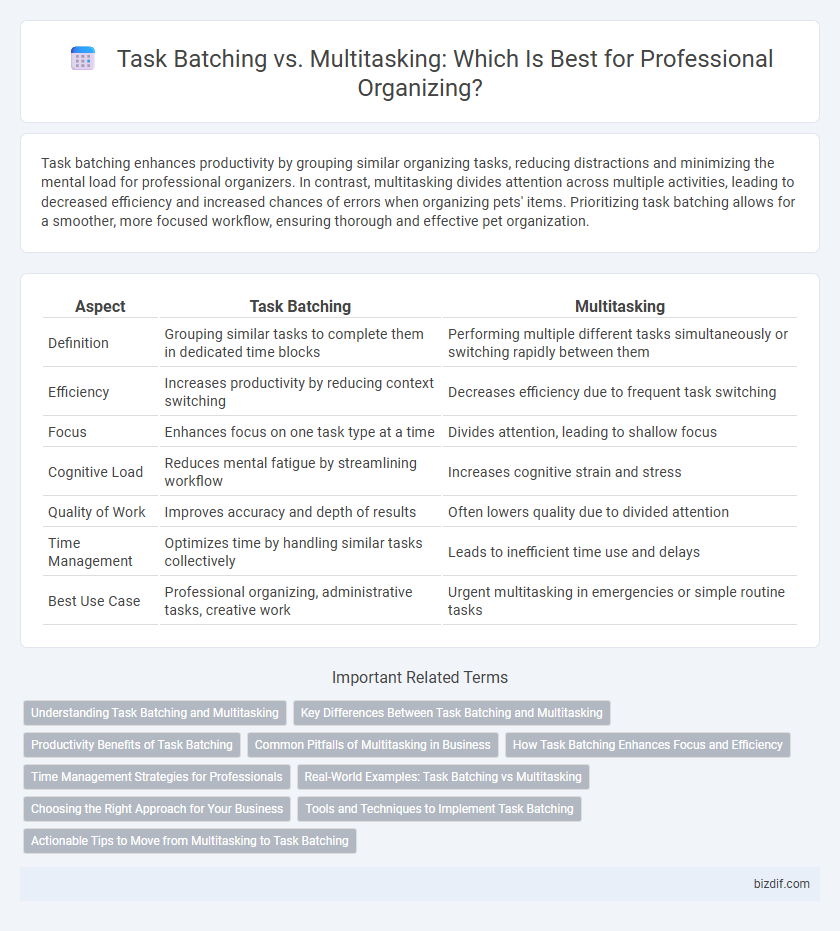Task batching enhances productivity by grouping similar organizing tasks, reducing distractions and minimizing the mental load for professional organizers. In contrast, multitasking divides attention across multiple activities, leading to decreased efficiency and increased chances of errors when organizing pets' items. Prioritizing task batching allows for a smoother, more focused workflow, ensuring thorough and effective pet organization.
Table of Comparison
| Aspect | Task Batching | Multitasking |
|---|---|---|
| Definition | Grouping similar tasks to complete them in dedicated time blocks | Performing multiple different tasks simultaneously or switching rapidly between them |
| Efficiency | Increases productivity by reducing context switching | Decreases efficiency due to frequent task switching |
| Focus | Enhances focus on one task type at a time | Divides attention, leading to shallow focus |
| Cognitive Load | Reduces mental fatigue by streamlining workflow | Increases cognitive strain and stress |
| Quality of Work | Improves accuracy and depth of results | Often lowers quality due to divided attention |
| Time Management | Optimizes time by handling similar tasks collectively | Leads to inefficient time use and delays |
| Best Use Case | Professional organizing, administrative tasks, creative work | Urgent multitasking in emergencies or simple routine tasks |
Understanding Task Batching and Multitasking
Task batching groups similar activities to improve focus and reduce transition time, increasing productivity by minimizing cognitive load. Multitasking divides attention across multiple tasks simultaneously but often leads to decreased efficiency and higher error rates due to frequent task-switching. Understanding the benefits of task batching over multitasking supports better time management and enhances overall work quality.
Key Differences Between Task Batching and Multitasking
Task batching involves grouping similar tasks to complete them consecutively, enhancing focus and reducing transition time, while multitasking requires switching between different tasks, often leading to decreased efficiency and increased errors. Key differences include task batching's promotion of deep work and reduced cognitive load versus multitasking's frequent interruptions and divided attention. Studies show task batching improves productivity by up to 40%, whereas multitasking can lower efficiency by as much as 40%.
Productivity Benefits of Task Batching
Task batching enhances productivity by grouping similar tasks together, minimizing context switching and reducing cognitive load. This method streamlines workflow, allowing professionals to complete tasks more efficiently and maintain sustained focus. Studies show that task batching can increase output by up to 40% compared to multitasking by optimizing mental resources.
Common Pitfalls of Multitasking in Business
Multitasking in business often leads to decreased productivity, increased errors, and heightened stress levels due to divided attention. Task batching, by grouping similar activities together, enhances focus and efficiency by minimizing cognitive switching costs. Common pitfalls of multitasking include fragmented workflow, missed deadlines, and compromised work quality, which task batching effectively addresses.
How Task Batching Enhances Focus and Efficiency
Task batching enhances focus and efficiency by grouping similar tasks together, reducing cognitive switching and minimizing distractions. This method streamlines workflow, allowing the brain to maintain sustained attention on one type of activity, which increases productivity and reduces errors. Studies show that task batching can improve work output by up to 40%, making it a superior strategy compared to multitasking.
Time Management Strategies for Professionals
Task batching optimizes time management by grouping similar tasks to minimize context switching, enhancing focus and productivity for professionals. Unlike multitasking, which divides attention and often reduces efficiency, task batching enables deeper concentration on each task, leading to higher quality outcomes. Implementing task batching in professional organizing streamlines workflows, reduces cognitive overload, and maximizes available time.
Real-World Examples: Task Batching vs Multitasking
Task batching streamlines productivity by grouping similar activities, such as responding to emails in one session, which reduces cognitive switching and enhances focus. Multitasking, like answering calls while drafting reports, often leads to fragmented attention and increased errors, demonstrated in studies where task-switching lowers efficiency by up to 40%. Real-world professionals report that adopting task batching improves time management and decreases stress compared to habitual multitasking.
Choosing the Right Approach for Your Business
Task batching improves efficiency by grouping similar tasks, reducing cognitive load and transition time, which is essential for businesses aiming to enhance productivity. Multitasking may seem efficient but often leads to decreased focus and higher error rates, negatively impacting overall performance. Evaluating the complexity and priority of tasks helps determine whether batching or multitasking aligns best with your business goals and workflow.
Tools and Techniques to Implement Task Batching
Effective tools for implementing task batching include digital calendars, time-blocking apps like Toggl Plan, and project management platforms such as Asana or Trello that facilitate grouping similar tasks to minimize context switching. Techniques like setting specific time slots for email processing, using the Pomodoro Technique to maintain focus within batches, and employing task categorization help streamline workflows and enhance productivity. Utilizing automation tools like Zapier can further reduce manual task transitions, reinforcing the efficiency of task batching methods.
Actionable Tips to Move from Multitasking to Task Batching
Task batching increases productivity by grouping similar tasks, reducing cognitive switching and minimizing distractions. Prioritize creating specific time blocks for focused work on related activities, allowing deeper concentration and efficiency. Use tools like timers and planners to schedule batched tasks, ensuring clear boundaries and measurable progress throughout the day.
task batching vs multitasking Infographic

 bizdif.com
bizdif.com